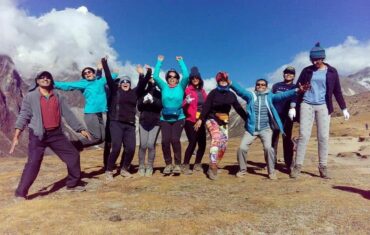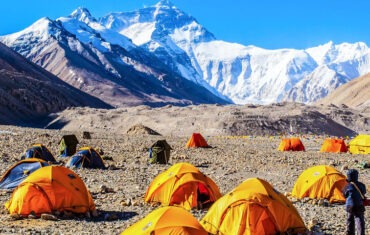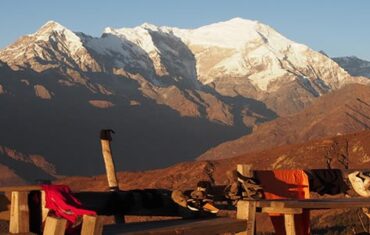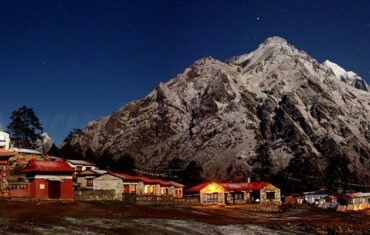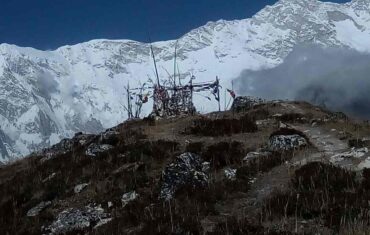Nepal is one of the most popular trekking destinations in the world, offering a wide range of trekking routes to choose from. If you are short on time and looking for a quick trekking adventure, here are the best short trekking routes in Nepal that you can consider:
Mardi Himal Trek:
Mardi Himal Trek is a relatively new trekking route in Nepal, located in the Annapurna region. The trek takes you through dense forests, beautiful villages, and breathtaking views of the Annapurna range. The trek is short but challenging, taking around 10 days to complete. The highest point on the trek is the Mardi Himal Base Camp, which offers stunning views of Machhapuchhre (Fishtail) and Mardi Himal.
Mardi Himal Trek Cost
The cost of the Mardi Himal Trek in Nepal can vary depending on various factors such as the season, duration of the trek, type of accommodation, transportation, and other personal expenses. Here is a breakdown of the estimated cost for the Mardi Himal Trek:
Trekking Permit and TIMS Card:
To trek in the Annapurna region, including the Mardi Himal Trek, you need to obtain a TIMS card (Trekkers’ Information Management System) and Annapurna Conservation Area Permit (ACAP). The cost for the TIMS card is around USD 10-20 per person, while the ACAP costs around USD 30-35 per person.
Accommodation:
Accommodation options along the Mardi Himal Trek are limited, with only a few tea houses and lodges available. The cost for a basic room can range from USD 5-15 per night, depending on the season and availability. However, if you prefer a more comfortable stay, you can also opt for luxury lodges that can cost up to USD 70 per night.
Food and Drinks:
The cost of food and drinks along the Mardi Himal Trek can vary depending on your preferences. A basic meal can cost around USD 5-10, while a cup of tea or coffee can cost around USD 2-4. However, the cost can be higher at higher altitudes and during peak seasons.
Transportation:
To reach the starting point of the Mardi Himal Trek, you need to take a private jeep or public bus from Kathmandu to Kande. The cost of a private jeep can range from USD 100-150, while a public bus can cost around USD 5-10 per person.
Guide and Porter:
If you prefer to hire a guide or porter for the trek, the cost can range from USD 20-30 per day for a guide and USD 15-20 per day for a porter.
Overall, the estimated cost for the Mardi Himal Trek can range from USD 500-800 per person for a 5-6 day trek, depending on the factors mentioned above. It is important to note that the cost can be higher during peak seasons such as spring and autumn, and it is always recommended to have some extra cash for any unforeseen expenses.
Mardi Himal Trek Difficulty
The Mardi Himal Trek is considered a moderate trek with a few challenging sections. The trek takes you through various terrain types, including steep ascents, descents, and narrow ridges. The highest point on the trek is Mardi Himal Base Camp, located at an altitude of 4,500 meters (14,764 feet), which requires a steep ascent. Therefore, it is important to have a good level of fitness and stamina to complete the trek comfortably.
The Mardi Himal Trek can take around 10 days to complete, with an average of 4-6 hours of walking per day. The trekking trail is well-marked and well-maintained, and there are few technical sections or dangerous crevasses to navigate.
However, the trek involves walking at high altitude, which can cause altitude sickness in some trekkers. It is important to acclimatize properly by taking enough rest and staying hydrated. Trekkers should also be prepared to face variable weather conditions, with temperatures dropping significantly at night and in higher altitudes.
Overall, while the Mardi Himal Trek is not the most challenging trek in Nepal, it still requires a good level of fitness and preparation. Trekkers should undertake some physical training before embarking on the trek and be aware of the potential risks associated with high altitude trekking. Hiring a guide or porter can also be helpful in ensuring a safe and comfortable trekking experience.
Best season for Mardi Himal Trek
The best season to do the Mardi Himal Trek in Nepal is from September to November (autumn) and March to May (spring). These are the peak trekking seasons in Nepal, with clear skies, stable weather conditions, and moderate temperatures.
During the autumn season (September to November), the weather is dry, and the skies are clear, making it the perfect time to enjoy the stunning mountain views. The temperatures are also moderate, with mild days and cool nights. This season is also ideal for those who want to avoid the monsoon season and have a relatively less crowded trekking trail.
The spring season (March to May) is also a great time to do the Mardi Himal Trek, as the rhododendrons and other wildflowers bloom along the trail, adding a colorful touch to the trek. The temperatures are also mild, and the skies are clear, providing great views of the surrounding mountains.
However, it’s important to note that the Mardi Himal Trek can be done throughout the year, but the monsoon season (June to August) should be avoided due to the heavy rainfall and potential landslides.
Overall, the best time to do the Mardi Himal Trek is during the autumn and spring seasons, when the weather is stable, and the trekking conditions are optimal.
Langtang Valley Trek:
Langtang Valley Trek is a beautiful trekking route that takes you through the Langtang region, located to the north of Kathmandu. The trek offers stunning views of the Langtang range, glaciers, and high-altitude lakes. The trek takes around 7-8 days to complete and is considered a moderate trek. The highest point on the trek is Tserko Ri, which offers panoramic views of the surrounding mountains.
Langtang Valley Trek Cost
The cost of the Langtang Valley Trek in Nepal can vary depending on various factors such as the season, duration of the trek, type of accommodation, transportation, and other personal expenses. Here is a breakdown of the estimated cost for the Langtang Valley Trek:
Trekking Permit and TIMS Card:
To trek in the Langtang region, including the Langtang Valley Trek, you need to obtain a TIMS card (Trekkers’ Information Management System) and Langtang National Park entry permit. The cost for the TIMS card is around USD 10-20 per person, while the Langtang National Park entry permit costs around USD 35 per person.
Accommodation:
Accommodation options along the Langtang Valley Trek are basic, with tea houses and lodges available. The cost for a basic room can range from USD 5-15 per night, depending on the season and availability. However, if you prefer a more comfortable stay, you can also opt for luxury lodges that can cost up to USD 70 per night.
Food and Drinks:
The cost of food and drinks along the Langtang Valley Trek can vary depending on your preferences. A basic meal can cost around USD 5-10, while a cup of tea or coffee can cost around USD 2-4. However, the cost can be higher at higher altitudes and during peak seasons.
Transportation:
To reach the starting point of the Langtang Valley Trek, you need to take a public bus or private jeep from Kathmandu to Syabrubesi. The cost of a private jeep can range from USD 100-150, while a public bus can cost around USD 5-10 per person.
Guide and Porter:
If you prefer to hire a guide or porter for the trek, the cost can range from USD 20-30 per day for a guide and USD 15-20 per day for a porter.
Overall, the estimated cost for the Langtang Valley Trek can range from USD 500-800 per person for a 7-10 day trek, depending on the factors mentioned above. It is important to note that the cost can be higher during peak seasons such as spring and autumn, and it is always recommended to have some extra cash for any unforeseen expenses.
Langtang Valley Trek Difficulty
The Langtang Valley Trek is considered a moderately challenging trek with a few difficult sections. The trek takes you through various terrain types, including steep ascents and descents, rocky trails, and narrow paths. The highest point on the trek is Tserko Ri, located at an altitude of 4,984 meters (16,352 feet), which requires a steep ascent. Therefore, it is important to have a good level of fitness and stamina to complete the trek comfortably.
The Langtang Valley Trek can take around 10 days to complete, with an average of 5-7 hours of walking per day. The trekking trail is well-marked and well-maintained, but there are some technical sections or dangerous crevasses to navigate, especially near the glaciers.
The trek also involves walking at high altitude, which can cause altitude sickness in some trekkers. It is important to acclimatize properly by taking enough rest and staying hydrated. Trekkers should also be prepared to face variable weather conditions, with temperatures dropping significantly at night and in higher altitudes.
Overall, while the Langtang Valley Trek is not the most challenging trek in Nepal, it still requires a good level of fitness and preparation. Trekkers should undertake some physical training before embarking on the trek and be aware of the potential risks associated with high altitude trekking. Hiring a guide or porter can also be helpful in ensuring a safe and comfortable trekking experience.
Best time to Visit Langtang Valley Trek
The best time to visit the Langtang Valley Trek is during the spring and autumn seasons, which are considered the peak trekking seasons in Nepal.
Spring Season (March-May):
During the spring season, the Langtang Valley Trek offers breathtaking views of blooming rhododendron forests and colorful wildflowers. The weather is generally clear with mild temperatures, making it a perfect time for trekking. The average temperature during this season ranges from 15 to 20 degrees Celsius (59 to 68 degrees Fahrenheit) at lower altitudes, while it drops to around 0 to 5 degrees Celsius (32 to 41 degrees Fahrenheit) at higher altitudes.
Autumn Season (September-November):
The autumn season is another popular time to visit the Langtang Valley Trek. The weather is clear with moderate temperatures and dry weather conditions, making it ideal for trekking. The average temperature during this season ranges from 10 to 15 degrees Celsius (50 to 59 degrees Fahrenheit) at lower altitudes, while it drops to around -5 to 5 degrees Celsius (23 to 41 degrees Fahrenheit) at higher altitudes.
It is important to note that the winter season (December-February) can also be a good time to trek in the Langtang Valley Trek, with fewer crowds and clear weather conditions. However, the temperatures can drop significantly, especially at higher altitudes, and snowfall can make the trail more challenging to navigate. The monsoon season (June-August) should be avoided, as the trail can be muddy and slippery, and there is a high risk of landslides and avalanches.
Overall, the best time to visit the Langtang Valley Trek is during the spring and autumn seasons when the weather is stable, the skies are clear, and the trail offers stunning views of the surrounding mountain peaks and landscapes.
Ghorepani Poon Hill Trek:
Ghorepani Poon Hill Trek is one of the most popular short trekking routes in Nepal, located in the Annapurna region. The trek offers stunning views of the Annapurna and Dhaulagiri ranges, along with beautiful rhododendron forests and charming villages. The trek takes around 4-5 days to complete and is considered an easy trek. The highest point on the trek is Poon Hill, which offers panoramic views of the surrounding mountains and sunrise.
Ghorepani Poon Hill Trek Cost
The cost of the Ghorepani Poon Hill Trek can vary depending on several factors such as the duration of the trek, the level of services required, and the time of year.
On average, the cost of the Ghorepani Poon Hill Trek ranges from $500 to $800 USD per person for a 7-10 day trek. This includes the cost of a guide and porter, permits, accommodation, meals, and transportation to and from the starting point of the trek.
If you choose to hire a porter to carry your bags, it can cost an additional $15 to $25 USD per day, depending on the weight of your bags.
The cost of the trek can also vary based on the level of accommodation and meals you choose. Basic teahouses and guesthouses are available along the trail, offering simple accommodation and traditional Nepalese meals at affordable prices. However, if you prefer more comfortable accommodation and international cuisine, it can add to the overall cost of the trek.
It’s important to note that the cost of the trek can be higher during peak trekking seasons, such as spring and autumn when the demand for services is high. It’s recommended to book your trek with a reputable trekking agency that can provide you with a detailed breakdown of the costs and ensure the safety and comfort of your trekking experience.
Ghorepani Poon Hill Trek Difficulty
The Ghorepani Poon Hill Trek is considered a relatively easy trek with a few moderate uphill sections. The trek is suitable for people of all ages and fitness levels, including beginners who are new to trekking.
The trek usually takes around 13 days to complete, with an average of 4-6 hours of walking per day. The trail is well-marked and well-maintained, with a good network of teahouses and guesthouses available along the way for meals and accommodation.
The highest point on the trek is Poon Hill, which is located at an altitude of 3,210 meters (10,531 feet). The ascent to Poon Hill is steep but not overly challenging, and the views from the top are spectacular, making it a highlight of the trek.
While the Ghorepani Poon Hill Trek is considered an easy trek, it is still important to have a good level of fitness and stamina to complete the trek comfortably. Trekkers should undertake some physical training before embarking on the trek to prepare their muscles for the long hours of walking.
It’s important to note that the trek also involves walking at high altitude, which can cause altitude sickness in some trekkers. It is important to acclimatize properly by taking enough rest and staying hydrated. Trekkers should also be prepared to face variable weather conditions, with temperatures dropping significantly at night and in higher altitudes.
Overall, the Ghorepani Poon Hill Trek is a relatively easy and accessible trek, making it a popular choice among trekkers of all levels. With its stunning views and well-maintained trail, it offers a rewarding trekking experience in the beautiful Annapurna region of Nepal.
Best time to visit Ghorepani Poon Hill Trek
The best time to visit the Ghorepani Poon Hill Trek is during the pre-monsoon season (late February to April) and post-monsoon season (September to November).
During these seasons, the weather is generally stable, with clear skies and dry weather, making it easier to trek and enjoy the stunning views of the Himalayas. The temperatures during these seasons are also mild, making it comfortable to trek during the day and sleep at night.
In the pre-monsoon season, the rhododendron flowers are in full bloom, adding a beautiful splash of color to the landscape. The post-monsoon season is also a great time to visit, as the weather is clear and the skies are generally less hazy, offering great views of the mountains.
During the winter months (December to February), the temperatures can be very cold, with snowfall and occasional blizzards in the higher altitudes. While the trek is still possible during this time, it can be more challenging due to the cold weather and snow-covered trails.
The monsoon season (June to August) is generally not recommended for trekking, as the trails can be slippery and muddy, and there is a higher risk of landslides and flooding.
Overall, the best time to visit the Ghorepani Poon Hill Trek is during the pre-monsoon and post-monsoon seasons, when the weather is stable and the views are spectacular.
Ghandruk Trek:
Ghandruk Trek is a short and easy trekking route that takes you through the beautiful village of Ghandruk, located in the Annapurna region. The trek offers stunning views of the Annapurna and Machhapuchhre ranges, along with charming traditional houses and terraced fields. The trek takes around 3-4 days to complete and is suitable for beginners. The highest point on the trek is Ghandruk Village, which offers stunning views of the surrounding mountains and traditional village life.
Ghandruk Trek Cost
The cost of the Ghandruk Trek in Nepal can vary depending on several factors, such as the duration of the trek, the level of accommodation and services, and the mode of transportation.
Generally, the cost of the trek can range from USD 300 to USD 800 per person for a 4-7 day trek. This cost typically includes permits, accommodation, food, and transportation to and from the starting point of the trek.
Accommodation options can range from basic teahouses to more luxurious lodges, with prices varying accordingly. The cost of food can also vary, with prices typically higher at higher altitudes due to the increased difficulty of transportation.
Additional costs may include the cost of hiring a guide and porter, which is recommended for trekkers who are new to the area or are not experienced in trekking. The cost of hiring a guide or porter can range from USD 20-25 per day for a guide and USD 15-20 per day for a porter.
It’s important to note that the cost of the trek can be significantly reduced for trekkers who are willing to travel independently and stay in basic teahouses. However, this option requires a good level of experience in trekking and navigating the trails.
Overall, the cost of the Ghandruk Trek can vary depending on the level of services and accommodation chosen, but it is generally an affordable trek compared to other popular trekking destinations in Nepal.
Best time to Visit Ghandruk Trek
Ghandruk Trek Difficulty
The Ghandruk Trek in Nepal is a moderate level trek, suitable for trekkers of all ages who are in good physical shape and have some prior trekking experience. The trek involves some uphill climbs and steep descents, but the trails are well-marked and relatively easy to navigate.
The trek typically takes 4-7 days to complete, with daily hikes averaging 5-7 hours of walking per day. The highest point of the trek is Tadapani, which sits at an altitude of 2,630 meters (8,629 feet). Trekkers should be prepared for the altitude and the potential for altitude sickness.
The trail passes through lush forests, terraced fields, and charming villages, offering a glimpse into the local culture and way of life. The trek also offers stunning views of the Annapurna and Machhapuchhre (Fishtail) mountains.
Trekkers are recommended to take regular breaks, stay hydrated, and acclimatize properly to the altitude. It is also recommended to bring proper trekking gear and equipment, including sturdy trekking shoes, warm clothing, and a good quality backpack.
Overall, while the Ghandruk Trek is considered a moderate level trek, it is still a challenging trek that requires good physical fitness and some prior trekking experience. However, with proper preparation and care, it can be an enjoyable and rewarding experience for trekkers of all ages.
Best time to Visit Ghandruk Trek
The best time to visit the Ghandruk Trek in Nepal is during the spring (March to May) and autumn (September to November) seasons.
During the spring season, the weather is generally mild and dry, with clear skies and blooming flowers along the trail. The temperatures are moderate, with daytime temperatures ranging from 15-25°C (59-77°F) and nighttime temperatures ranging from 0-10°C (32-50°F). However, the trail can be busier during this time, as it is a popular trekking season in Nepal.
During the autumn season, the weather is also mild and dry, with clear skies and excellent visibility of the surrounding mountains. The temperatures are similar to those in the spring, and the trail is generally less crowded. This season is also a popular time for festivals in Nepal, which can add to the cultural experience of the trek.
The summer (June to August) and winter (December to February) seasons are generally not recommended for the Ghandruk Trek due to the high risk of monsoon rains and snowfall, which can make the trail muddy, slippery, and difficult to navigate. Additionally, the winter season can bring extremely cold temperatures and limited visibility, making it challenging for trekking.
Overall, the best time to visit the Ghandruk Trek is during the spring and autumn seasons, when the weather is mild, dry, and the trail is generally in good condition.
In conclusion, Nepal offers a wide range of short trekking routes that are perfect for those who are short on time but still want to experience the beauty of the Himalayas. The Mardi Himal Trek, Langtang Valley Trek, Ghorepani Poon Hill Trek, and Ghandruk Trek are some of the best short trekking routes in Nepal that you can consider for a quick adventure.



